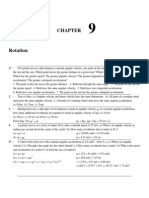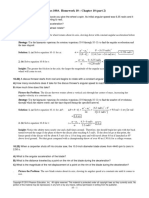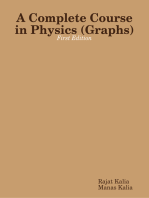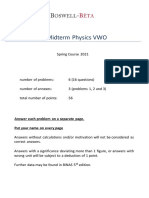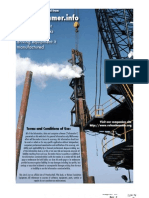Homework #10 Solutions
Homework #10 Solutions
Uploaded by
Marco ConopioCopyright:
Available Formats
Homework #10 Solutions
Homework #10 Solutions
Uploaded by
Marco ConopioOriginal Description:
Original Title
Copyright
Available Formats
Share this document
Did you find this document useful?
Is this content inappropriate?
Copyright:
Available Formats
Homework #10 Solutions
Homework #10 Solutions
Uploaded by
Marco ConopioCopyright:
Available Formats
Homework #10 Solutions
5 problems
1. What is the angular speed of (a) the second hand, (b) the minute hand, and (c) the hour hand of a smoothly running analog watch? Answer in radians per second. (a) The second hand turns through 2 radians in 60 s, so = 2 = 0.105 rad/s 60 s
(b) The minute hand turns through 2 radians in 60 min = 3600 s, so = 2 = 1.75 103 rad/s 3600 s
3600 s 1 hr
(c) The hour hand turns through 2 radians in 12 hr =
= 43200 s, so
2 = 1.45 104 rad/s 43200 s
2. A merry-go-round rotates from rest with an angular acceleration of 1.50 rad/s2 . How long does it take to rotate through (a) the rst 2.00 rev and (b) the next 2.00 rev? (a) Let the starting moment be when the merry-go-round is at rest, and the ending moment be 2 revolutions later. If we assume that 0 = 0, then = 2 rev = 4 rad. The initial angular velocity is 0 = 0 rad/s, and the angular acceleration is = 1.5 rad/s2 . We want to nd the time, and we dont know or need the nal angular velocity . Thus we want the equation which does not involve : 1 = 0 + 0 t + t2 2 1 4 = 0 + 0t + (1.5)t2 2 8 2 = t = = 16.8 s2 1.5 = t = 16.8 s2 = 4.1 s (b) The time it takes for the wheel to spin four complete revolutions, starting from rest, can be found using the same equation: 1 8 = (1.5)t2 = t = 33.6 s2 = 5.8 s 2 Thus the time it takes to rotate the second two revolutions is 5.8 s 4.1 s = 1.7 s
3. A ywheel turns through 40 rev as it slows from an angular speed of 1.5 rad/s to a stop. (a) Assuming a constant angular acceleration, nd the time for it to come to rest. (b) What is its angular acceleration? (c) How much time is required for it to complete the rst 20 of the 40 revolutions?
Whaddya know, whaddya need? We know that 0 = 40 rev = 0 rad/s. We need t and .
2 rad 1 rev
= 251 rad, 0 = 1.5 rad/s, and
(a) If we start with t rst, we choose the equation that doesnt have in it: 0 = 1 ( + 0 )t 2 2( 0 ) = t = + 0 2(251 rad) t = = 335 s 1.5 rad/s
(b) Next we need , which we can get from the easy equation = 0 + t 0 = = t 0 1.5 = 4.48 103 rad/s2 = 335
Finally, we want to know how long it takes to make the rst 20 spins, so we have a new event here: 0 = 0 as before, = 20 rev = 125 rad. We dont know the nal speed, but we know the angular acceleration, and so 1 0 = 0 t + t2 2 1 125 = (1.5)t + (0.00448)t2 2 = 0.00224t2 1.5t + 125 = 0 1.5 = t = 1.52 4(125)(0.00224) 2(0.00224)
t = 572 s, 97.5 s There are two positive roots; which one is right? Well, if it takes 335 s to make 40 revolutions, it must take less time to make 20, and so 97.5 s is the correct answer. (The other answer comes in if the wheel keeps accelerating after it stops, rewinding the number of revolutions from 40 back to 20.) Notice that it takes 98 s to make the rst 20 revolutions, and 335 98 = 237 s to make the next 20; sensible because the wheel is moving a lot faster at the beginning. 4. Wheel A of radius rA = 10 cm is coupled by belt B to wheel C of radius rC = 25 cm. The angular speed of wheel A is increased from rest at a constant rate of 1.6 rad/s2 . Find the time needed for wheel C to reach an angular speed of 100 rev/min, assuming the belt does not slip.
Since the belt does not slip, a point on the rim of wheel C has the same linear motion as a point on the rim of wheel A, including the same tangential acceleration at . Since at = r, that means that A rA = C rC , where is the angular acceleration and r is the radius of the specied wheel. Wheel A has an angular acceleration of A = 1.6 rad/s2 , so wheel C has an angular acceleration of C = 10 cm rA A = (1.6 rad/s2 ) = 0.64 rad/s2 rC 25 cm
If wheel C starts from rest, then its angular velocity as a function of time is C = C t, so the time it takes for it to reach 1 min 2 rad rev C = 100 = 10.5 rad/s min 60 s 1 rev is C 10.5 rad/s t= = 16 s = C 0.64 rad/s2 5. Four identical particles of mass 0.50 kg each are placed at the vertices of a 2.0 m 2.0 m square and held there by four massless rods, which form the sides of the square. What is the rotational inertia of this rigid body about an axis that (a) passes through the midpoints of opposite sides and lies in the plane of the square, (b) passes through the midpoint of one of the sides and is perpendicular to the plane of the square, and (c) lies in the plane of the square and passes through two diagonally opposite particles?
(a)
1 2 1
(b)
2 1
(c)
2
2m
2m
2m
The moment of inertia of four particles, i = 1, . . . , 4, is equal to I = the particle to the axis. All four particles have mi = 0.50 kg. (a) All four particles are a distance 1 m from the axis, so
2 mi ri where ri is the distance from
I = (0.50 kg) (1 m)2 + (1 m)2 + (1 m)2 + (1 m)2 = 2 kg m2
(b) Particles 1 and 4 are a distance r = 1 m from the axis. Particles 2 and 3 are a distance Thus I = (0.50 kg) 1 m2 + 1 m2 + 5 m2 + 5 m2 = 6 kg m2
22 + 12 =
5 m.
(c) Particles 1 and 3 are on the axis, so contribute nothing to the inertia. Particles 2 and 4 are a distance 2 meters from the axis. Therefore I = (0.50 kg) 2 m2 + 2 m2 = 2 kg m2
You might also like
- TYCO - Battery Charger PSU830Document10 pagesTYCO - Battery Charger PSU830RM Haroon100% (2)
- CH 09Document26 pagesCH 09Sultan Almassar0% (1)
- Tutorial Week 4 SolutionsDocument4 pagesTutorial Week 4 Solutionspaul chenNo ratings yet
- On Kinematic Equations For Rotational MotionDocument27 pagesOn Kinematic Equations For Rotational MotionAaliyah Bennett TrillesNo ratings yet
- Angular MotionDocument4 pagesAngular MotionmikezewelanjisinyangweNo ratings yet
- PHYS 1120 Rotational Kinematics SolutionsDocument7 pagesPHYS 1120 Rotational Kinematics SolutionsEnger AlingasaNo ratings yet
- Physics 1120: Rotational Kinematics SolutionsDocument7 pagesPhysics 1120: Rotational Kinematics SolutionsNykia Bhelle Lansangan CarpioNo ratings yet
- Rotational Kinematics Worksheet PacketDocument12 pagesRotational Kinematics Worksheet PacketElias MaciasNo ratings yet
- Rotational MotionDocument112 pagesRotational Motionriyanshi1612No ratings yet
- Chapter 7-Rotational MotionDocument59 pagesChapter 7-Rotational MotionSuganeya UdiasoorianNo ratings yet
- Unit 8 Practice ProblemsDocument71 pagesUnit 8 Practice ProblemsAli RazaNo ratings yet
- Module 1Document17 pagesModule 1robejr2013No ratings yet
- Ch09 SSM 070904Document26 pagesCh09 SSM 070904VinhTranNo ratings yet
- Phy - G 11-CH-6Document17 pagesPhy - G 11-CH-6Metiku DigieNo ratings yet
- Rotational Dynamics Lecture 01Document44 pagesRotational Dynamics Lecture 01KaranNo ratings yet
- JEE Mains Q.bank Circular MotionDocument63 pagesJEE Mains Q.bank Circular MotionTapankumar Sanyal50% (4)
- Igcse Sample PaperDocument8 pagesIgcse Sample PaperharshanauocNo ratings yet
- Physics 100A Homework 10 - Chapter 10 (Part 2)Document4 pagesPhysics 100A Homework 10 - Chapter 10 (Part 2)Wendell CapiliNo ratings yet
- P211 C7 SolutionsDocument13 pagesP211 C7 SolutionsKang CepotNo ratings yet
- 6 Uniform Circular MotionDocument83 pages6 Uniform Circular MotionRamachandranPerumal0% (1)
- Circular MotionpdfDocument24 pagesCircular MotionpdfChandra SekharNo ratings yet
- ISV SM Ch10Document69 pagesISV SM Ch10손은결No ratings yet
- Tan Jan Lloyd C. Chapter 5 Rotation 20 22Document5 pagesTan Jan Lloyd C. Chapter 5 Rotation 20 22Norjana BarabatoNo ratings yet
- Dynamica HS16Document91 pagesDynamica HS16Mert Keskin80% (5)
- Physics Chap 7Document14 pagesPhysics Chap 7Shivali PatelNo ratings yet
- Plane Trigonometry: OA Be The Initial Side OB Be The Terminal SideDocument14 pagesPlane Trigonometry: OA Be The Initial Side OB Be The Terminal SideJo HarNo ratings yet
- Ch-Circular Motion Lect 01final NotesDocument60 pagesCh-Circular Motion Lect 01final Notessujaykumarsingh3810No ratings yet
- ACTIVITY IN ROTATION MOTION AutosavedDocument4 pagesACTIVITY IN ROTATION MOTION AutosavedJolo FernandoNo ratings yet
- Instant Download College Physics 10th Edition Young Solutions Manual PDF All ChapterDocument48 pagesInstant Download College Physics 10th Edition Young Solutions Manual PDF All ChapternorbeynemsNo ratings yet
- Rotational Kinematics Worksheet PacketDocument12 pagesRotational Kinematics Worksheet PacketAbraham RobinsonNo ratings yet
- Curvilinear MotionDocument22 pagesCurvilinear MotionRjay FloresNo ratings yet
- Chapter 10: Rotation 10.1: What Is Physics?: Translational MotionDocument9 pagesChapter 10: Rotation 10.1: What Is Physics?: Translational MotionSaqr HattabNo ratings yet
- Higher Eng Maths 9th Ed 2021 Solutions ChapterDocument46 pagesHigher Eng Maths 9th Ed 2021 Solutions ChapterAubrey JosephNo ratings yet
- Download Study Resources for College Physics 10th Edition Young Solutions ManualDocument44 pagesDownload Study Resources for College Physics 10th Edition Young Solutions Manualhokwankuya100% (6)
- Angular MotionDocument21 pagesAngular Motionsuperman618No ratings yet
- Physics Chapter 10 AnswersDocument40 pagesPhysics Chapter 10 AnswersAbovethesystem100% (14)
- Dyna ProjectDocument47 pagesDyna ProjectCris Vincent Rivera Sedanto61% (23)
- PDF College Physics 10th Edition Young Solutions Manual downloadDocument41 pagesPDF College Physics 10th Edition Young Solutions Manual downloadahujachaisi6100% (1)
- Circular MotionDocument29 pagesCircular MotionRamlloyd SuelloNo ratings yet
- Mechanicsssssss ExamplesDocument9 pagesMechanicsssssss ExamplesJhonrey Joey DesabilleNo ratings yet
- M10 Wolf57139 03 Se C10Document30 pagesM10 Wolf57139 03 Se C10c.s.kalkmanNo ratings yet
- Solved Questions MTM PDFDocument12 pagesSolved Questions MTM PDFRajendrakumarNo ratings yet
- Suvat Equivalents - 1st Qs SheetDocument4 pagesSuvat Equivalents - 1st Qs SheetphydotsiNo ratings yet
- CHAPTER 1 (Part 1.1) - WEEK 1Document20 pagesCHAPTER 1 (Part 1.1) - WEEK 1Aliaa AkbarNo ratings yet
- Circular Motion 3Document41 pagesCircular Motion 3Raja BabuNo ratings yet
- Physics Grade 11 Unit Six Summary: Angular Motion /rotational Motion/ By:Addis Ababa Education Bureau MAY 2020Document42 pagesPhysics Grade 11 Unit Six Summary: Angular Motion /rotational Motion/ By:Addis Ababa Education Bureau MAY 2020Sun TechNo ratings yet
- Rotational MotionDocument54 pagesRotational MotionMohammed Aftab Ahmed100% (3)
- Multiple Choice RotationDocument20 pagesMultiple Choice RotationJohnathan BrownNo ratings yet
- Nonuniform Circular Motions Problems and Solutions PDFDocument1 pageNonuniform Circular Motions Problems and Solutions PDFBasic PhysicsNo ratings yet
- Nonuniform Circular Motions Problems and SolutionsDocument1 pageNonuniform Circular Motions Problems and SolutionsBasic PhysicsNo ratings yet
- Ujian Pra Dan Pos Kajian Tindakan FizikDocument1 pageUjian Pra Dan Pos Kajian Tindakan FizikFARRAH LAILY BINTI ALILI KPM-GuruNo ratings yet
- 7-1 Centripetal Acceleration and Force Problems Answer KeyDocument7 pages7-1 Centripetal Acceleration and Force Problems Answer KeyAisyah Asri100% (1)
- All DPPDocument47 pagesAll DPPnavojeyaram123No ratings yet
- Lesson 1: Rectilinear Translation MotionDocument39 pagesLesson 1: Rectilinear Translation MotionAaron EserNo ratings yet
- Applications of Derivatives Rate of Change (Calculus) Mathematics Question BankFrom EverandApplications of Derivatives Rate of Change (Calculus) Mathematics Question BankNo ratings yet
- O level Physics Questions And Answer Practice Papers 2From EverandO level Physics Questions And Answer Practice Papers 2Rating: 5 out of 5 stars5/5 (1)
- Philippine Studies: Historical and Ethnographic ViewpointsDocument19 pagesPhilippine Studies: Historical and Ethnographic ViewpointsMarco ConopioNo ratings yet
- CE22 - 06 - Nominal Effective Interest RateDocument42 pagesCE22 - 06 - Nominal Effective Interest RateMarco ConopioNo ratings yet
- Remote Estimation of Chlorophyll-A Concentration in Turbid Water Using A Spectral Index: A Case Study in Taihu Lake, ChinaDocument25 pagesRemote Estimation of Chlorophyll-A Concentration in Turbid Water Using A Spectral Index: A Case Study in Taihu Lake, ChinaMarco ConopioNo ratings yet
- Lecture 3Document10 pagesLecture 3Marco ConopioNo ratings yet
- CE 22 - Engineering Economy: General InstructionsDocument1 pageCE 22 - Engineering Economy: General InstructionsMarco ConopioNo ratings yet
- EE ch2 2 (ST) PDFDocument34 pagesEE ch2 2 (ST) PDFZyren Jay G. MaganaNo ratings yet
- Remote Sensing, 10 (8), 1227. Doi:10.3390/rs10081227Document1 pageRemote Sensing, 10 (8), 1227. Doi:10.3390/rs10081227Marco ConopioNo ratings yet
- 9 Line of Intersection of PlanesDocument6 pages9 Line of Intersection of PlanesMarco ConopioNo ratings yet
- 7 Interest Lec5Document52 pages7 Interest Lec5Marco ConopioNo ratings yet
- 16 Auxiliary ViewsDocument14 pages16 Auxiliary ViewsMarco ConopioNo ratings yet
- 3 - Geometric Construction 3 Ver2Document29 pages3 - Geometric Construction 3 Ver2Marco ConopioNo ratings yet
- Conopio Japor Thesis Proposal PaperDocument5 pagesConopio Japor Thesis Proposal PaperMarco ConopioNo ratings yet
- Electrical Quan - Es, KCL, KVL: EEE 3 Lecture 01Document25 pagesElectrical Quan - Es, KCL, KVL: EEE 3 Lecture 01Marco ConopioNo ratings yet
- Relocation SurveyDocument2 pagesRelocation SurveyMarco ConopioNo ratings yet
- 2 - Geometric Construction 2Document84 pages2 - Geometric Construction 2Marco ConopioNo ratings yet
- GE 155.1 4C Group 4 LabEx 1Document18 pagesGE 155.1 4C Group 4 LabEx 1Marco ConopioNo ratings yet
- E03 Circuit Analysis (v2) PDFDocument9 pagesE03 Circuit Analysis (v2) PDFMarco ConopioNo ratings yet
- GsE 189 Lab Exercise 1Document9 pagesGsE 189 Lab Exercise 1Marco ConopioNo ratings yet
- An-42007 AN42007 Safety, EMI and RFI ConsiderationsDocument6 pagesAn-42007 AN42007 Safety, EMI and RFI ConsiderationsSunu PradanaNo ratings yet
- Electric Field and Charge at The Corner or Edge: Masahiro YamamotoDocument3 pagesElectric Field and Charge at The Corner or Edge: Masahiro YamamotoAndres VegaNo ratings yet
- Mechanisms, Linkage Geometry, and CalculationsDocument21 pagesMechanisms, Linkage Geometry, and CalculationsDr. Birajashis Pattnaik100% (2)
- MIdterm 1 2021Document10 pagesMIdterm 1 2021Clive AnnanNo ratings yet
- NEET & JEE Training Schedule-Mt - Literazee, CBEDocument38 pagesNEET & JEE Training Schedule-Mt - Literazee, CBEBALAYASJNo ratings yet
- Pile Driving MethodDocument91 pagesPile Driving MethodDiego D. Mantilla75% (4)
- Vdo SensorsDocument5 pagesVdo SensorsAbdul KhaliqNo ratings yet
- Electric Drives and ControlDocument1 pageElectric Drives and Controlveeramaniks408No ratings yet
- Intro CsamtDocument4 pagesIntro CsamtJoshLeighNo ratings yet
- Single Relay - REL-OR2/LDP-24DC/2X21 - 2903689: Key Commercial DataDocument7 pagesSingle Relay - REL-OR2/LDP-24DC/2X21 - 2903689: Key Commercial DataabcdNo ratings yet
- Eocr 3de 3ez 2 PDFDocument1 pageEocr 3de 3ez 2 PDFKALYANNo ratings yet
- Dynamic Relaxation Analysis of The Non-Linear Static Response of Pretensioned Cable RoofsDocument9 pagesDynamic Relaxation Analysis of The Non-Linear Static Response of Pretensioned Cable RoofsJoaquin VieraNo ratings yet
- Moving-Vessel Ps Final TermDocument1 pageMoving-Vessel Ps Final Termleamay.suansonNo ratings yet
- Comparative Study of Interior Permanent Magnet, Induction, and Switched Reluctance Motor Drives For EV and HEV ApplicationsDocument10 pagesComparative Study of Interior Permanent Magnet, Induction, and Switched Reluctance Motor Drives For EV and HEV Applicationskhodabandelou100% (1)
- Finite Element Motional Electro-Magnetic Modeling of A 100kW eVTOL Permanent Magnet Motor-Esdras Lopez PDFDocument1 pageFinite Element Motional Electro-Magnetic Modeling of A 100kW eVTOL Permanent Magnet Motor-Esdras Lopez PDFSteph ClicheNo ratings yet
- STATCOM For RailwaysDocument5 pagesSTATCOM For RailwaysDebayan BhattacharyaNo ratings yet
- Practice Test 1 - 2 (MCQS) - Test 35Document12 pagesPractice Test 1 - 2 (MCQS) - Test 35phamngoctramgiois1tgNo ratings yet
- Optimized Design For TSHDs Swell CompensatorDocument13 pagesOptimized Design For TSHDs Swell CompensatorTomasz FelknerNo ratings yet
- Em IDocument62 pagesEm IAiv DeeNo ratings yet
- PhySci GR 11 September ConTest EngDocument14 pagesPhySci GR 11 September ConTest Engthandekadlamini354No ratings yet
- 11 KV Network ElementDocument11 pages11 KV Network ElementKuldip PrasadNo ratings yet
- E HPCL Electronics Question Paper Sample Model Placement PaperDocument9 pagesE HPCL Electronics Question Paper Sample Model Placement PaperNaveen SharmaNo ratings yet
- Crosstalk: Calculation and SLEMDocument35 pagesCrosstalk: Calculation and SLEMspyeagleNo ratings yet
- Comparing Impact of STATCOM and SSSC On The Performance of Digital Distance RelayDocument7 pagesComparing Impact of STATCOM and SSSC On The Performance of Digital Distance RelayJimmy Alexander BarusNo ratings yet
- MV Viva QuestionsDocument12 pagesMV Viva QuestionsOMKAR KULKARNINo ratings yet
- Today's Objectives:: Mass Moment of InertiaDocument15 pagesToday's Objectives:: Mass Moment of InertiaAtef NazNo ratings yet
- (3922) DPP VijayDocument135 pages(3922) DPP VijayjamesNo ratings yet
- Railway Track DesignDocument24 pagesRailway Track Designalogentle80% (5)

